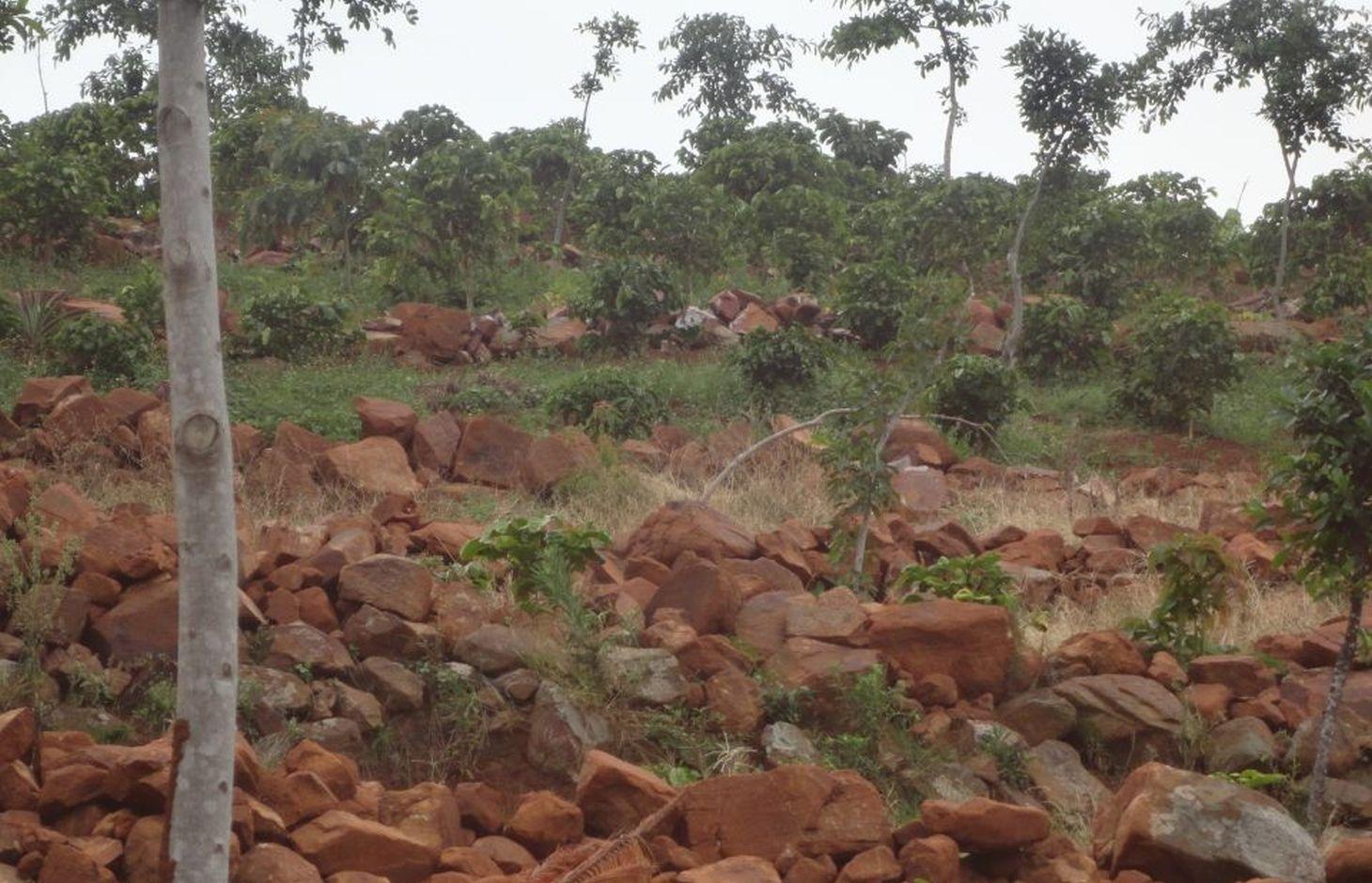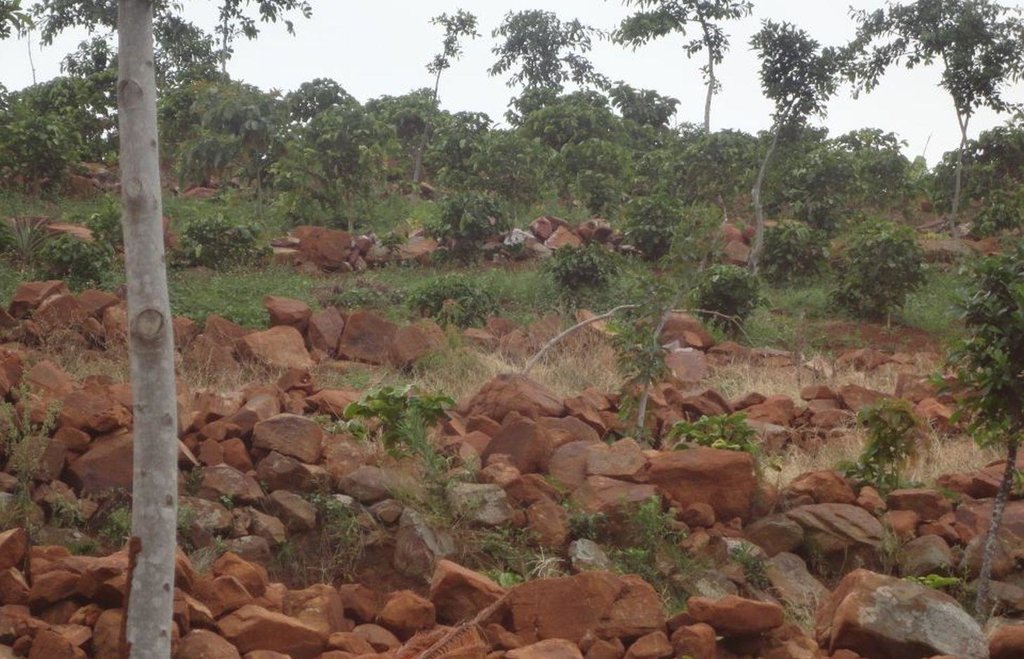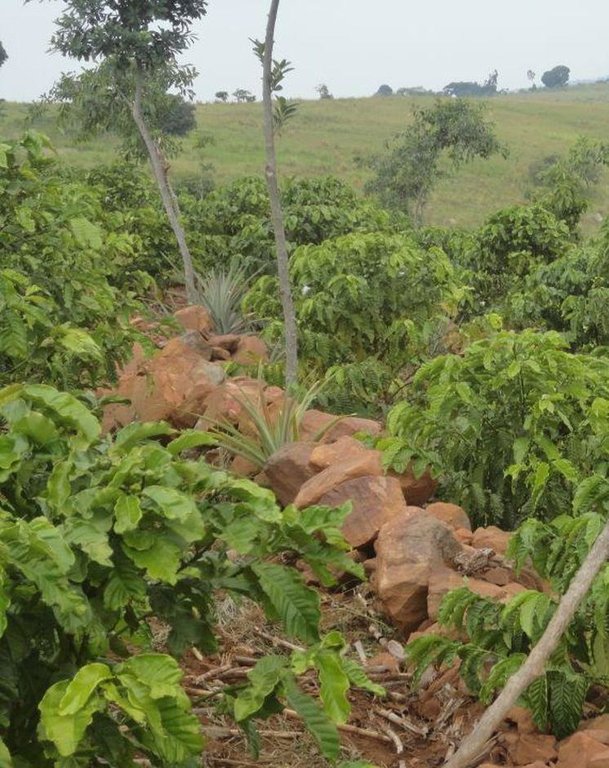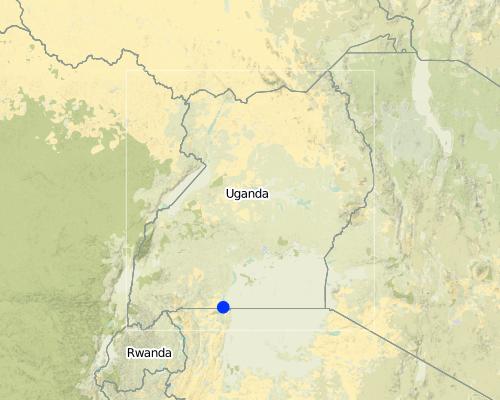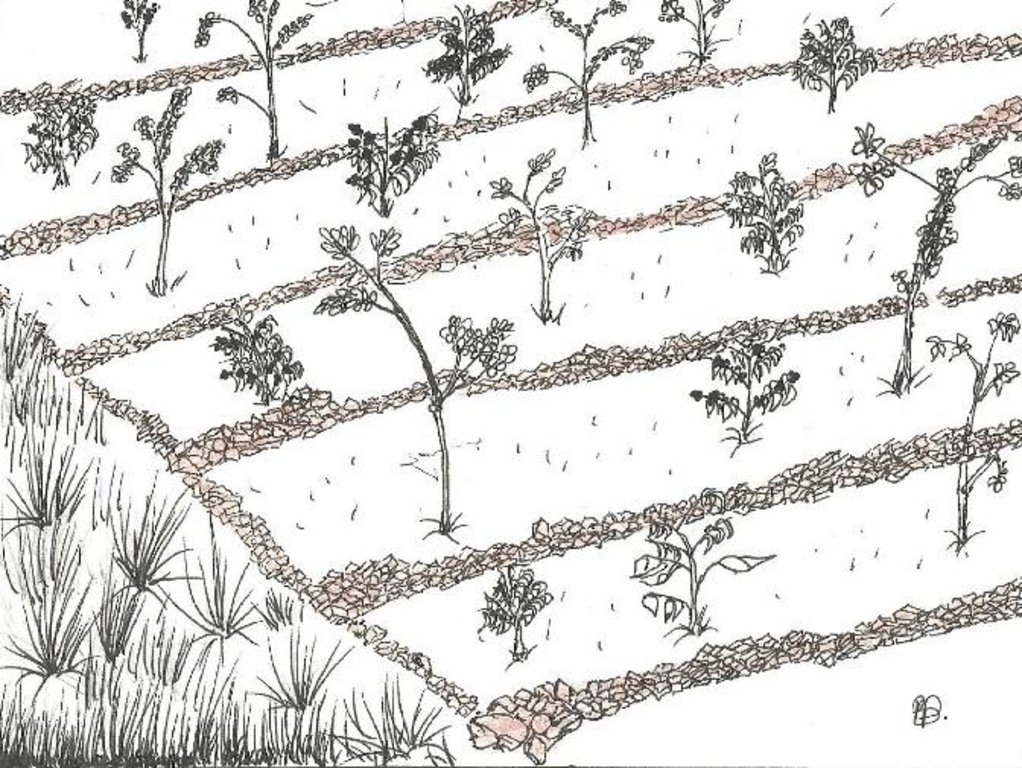Ficus Natalensis Agroforestry System [乌干达]
- 创建:
- 更新:
- 编制者: Wilson Bamwerinde
- 编辑者: –
- 审查者: Fabian Ottiger
Okusimba emituba n'ebimera
technologies_1153 - 乌干达
查看章节
全部展开 全部收起1. 一般信息
1.2 参与该技术评估和文件编制的资源人员和机构的联系方式
SLM专业人员:
SLM专业人员:
SLM专业人员:
Lubega Emmanuel
Rakai district
乌干达
有助于对技术进行记录/评估的项目名称(如相关)
The Transboundary Agro-ecosystem Management Project for the Kagera River Basin (GEF-FAO / Kagera TAMP )有助于对技术进行记录/评估的机构名称(如相关)
FAO Food and Agriculture Organization (FAO Food and Agriculture Organization) - 意大利1.3 关于使用通过WOCAT记录的数据的条件
(现场)数据是什么时候汇编的?:
05/12/2013
编制者和关键资源人员接受有关使用通过WOCAT记录数据的条件。:
是
1.5 请参阅有关SLM方法的问卷

Community development appraoch [乌干达]
The approach involves the community and other development partners identifying opportunities, challenges and appropriate solutions through collective action.
- 编制者: Wilson Bamwerinde
2. SLM技术的说明
2.1 技术简介
技术定义:
Ficus natalensis based agroforestry system protects crops on windy hill slopes facing Lake Victoria and reduce runoff towards the meandering Kagera River Valley.
2.2 技术的详细说明
说明:
Ficus natalensis is traditionally scattered in crop fields as a land management practice in central and south-western Uganda. The improved technology designed through community participation involves planting lines of Ficus natalensis along the contour at an interval that enables the tree to provide shade to young crops without depriving them of sunshine. When planted together with coffee trees or in banana plantations, the tall Ficus tree forms the top storey that protects the crop from the hot sun.
Purpose of the Technology: The main purpose of Ficus based agroforestry is to protect the soil from erosion. Within 3 to 5 years the Ficus tree forms a deep root system that stabilizes the soil. In addition, it drops leaves which quickly decay to provide both soil cover and manure thereby increasing the fertility of the soil. The trees provide firewood, fodder for livestock and bark cloth which can be used domestically or sold to supplement household income. They also act as wind breaks.
Establishment / maintenance activities and inputs: Ficus Natalensis is propagated using cuttings from young branches which are planted vertically 6 m apart along a contour. Propagation material is readily available and cheap, making the technology inexpensive to establish. Any annual or perennial crop can be inter-cropped with Ficus spp. provided the tree canopy is managed well. The tree is quite robust and can attain heights of over 20m, with a very extensive canopy if left to grow. Pruning raises its canopy to the desired height above the ground. In its early stages, fencing is required to protect the tree from damage by livestock. Within 12 to 18 months, however, the tree is established enough to withstand browsing. Only simple tools like hoes and garden forks for digging holes/pits are essential for establishment of the technology. The implementation of the technology on steep slopes (> 50%) is not possible without other supportive SLM interventions, in Rakai these include construction of stone lines and mulch application.
Natural / human environment: The pruned branches of Ficus natalensis are used as fuel wood when dry. Therefore scarcity of fuel wood may lead to over-harvesting of branches and destroying the canopy. Nonetheless, the tree regenerates quickly with the coming of the rains. Ficus tree can live for a hundred years.
2.3 技术照片
2.5 已应用该技术的、本评估所涵盖的国家/地区/地点
国家:
乌干达
区域/州/省:
Uganda
有关地点的进一步说明:
Rakai District (Kijonjo Parish)
注释:
Boundary points of the Technology area: -0.96681 31.69066; -0.96706 31.69111; -0.96717 31.69033; -0.96757 31.69038; -0.96774 31.69073
Map
×2.6 实施日期
如果不知道确切的年份,请说明大概的日期:
- 不到10年前(最近)
2.7 技术介绍
详细说明该技术是如何引入的:
- 通过项目/外部干预
注释(项目类型等):
Agroforestry is a traditional practice but was reintroduced in a better structured, systematic form by organizations like VI-Agroforestry and Kagera TAMP.
3. SLM技术的分类
3.1 该技术的主要目的
- 减少、预防、恢复土地退化
- 创造有益的经济影响
3.2 应用该技术的当前土地利用类型

农田
- 一年一作
- 多年一作(非木材)
- 乔木与灌木的种植
主要农作物(经济作物及粮食作物):
Major cash crop tree and shrub cropping: Coffee
Major food crop perennial (non-woody) cropping: Banana
Major food crop annual cropping: Maize and beans

混合(作物/放牧/树木),包括农林
- 农林业
主要产品/服务:
Major cash crop: Coffee
Major food crop: Bananas
Major other crop: Ficus Spp.
注释:
Major land use problems (compiler’s opinion): Severe deforestation as trees were cut down for firewood, charcoal, timber and for agricultural use;
Overgrazing
Major land use problems (land users’ perception): Prolonged dry weather, destructive rainstorms and declining soil fertility
Type of cropping system and major crops comments: Agro-forestry is used in combination with banana and coffee growing.
3.3 有关土地利用的更多信息
该技术所应用土地的供水:
- 雨养
每年的生长季节数:
- 2
具体说明:
Longest growing period in days: 120 Longest growing period from month to month: February to May Second longest growing period in days: 120 Second longest growing period from month to month: September to December
3.4 该技术所属的SLM组
- 农业林学
3.5 技术传播
注释:
Total area covered by the SLM Technology is 0.06 m2.
The technology is becoming dominant in Kijonjo parish and other parts of Rakai district especially due to climatic changes that have led to shorter rainy seasons. However, farmers also recognize its potential for soil conservation.
3.6 包含该技术的可持续土地管理措施

农艺措施
- A6:其它

植物措施
- V1:乔木和灌木覆盖层

结构措施
- S11:其它
注释:
Main measures: vegetative measures
Specification of other agronomic measures: mulching (supp.
Specification of other structural measures: stone lines (supp.
Type of vegetative measures: aligned: -contour
3.7 该技术强调的主要土地退化类型

土壤水蚀
- Wt:表土流失/地表侵蚀

生物性退化
- Bc:植被覆盖的减少
- Bq:数量/生物量减少
注释:
Main type of degradation addressed: Wt: loss of topsoil / surface erosion, Bc: reduction of vegetation cover, Bq: quantity / biomass decline
Main causes of degradation: soil management (Lack of conservation measures), crop management (annual, perennial, tree/shrub) (Over cultivation), deforestation / removal of natural vegetation (incl. forest fires) (Cutting trees for timber and opening up more agricultural land), over-exploitation of vegetation for domestic use (Cutting trees for fuel wood and charcoal), poverty / wealth, education, access to knowledge and support services
Secondary causes of degradation: other natural causes (avalanches, volcanic eruptions, mud flows, highly susceptible natural resources, extreme topography, etc.) specify (Steep and very steep slopes)
3.8 防止、减少或恢复土地退化
具体数量名该技术与土地退化有关的目标:
- 减少土地退化
4. 技术规范、实施活动、投入和成本
4.1 该技术的技术图纸
4.2 技术规范/技术图纸说明
A diagram showing Ficus spp. trees planted to provide shade to coffee trees.
Location: Kijonjo B. village. Rakai
Date: 2013-12-05
Technical knowledge required for field staff / advisors: moderate (Knowledge of which trees will do well with the crops to be cultivated)
Technical knowledge required for land users: low (Land user dedication and a little guidance is enough for the implementation of the technology.)
Main technical functions: control of raindrop splash, control of dispersed runoff: impede / retard, improvement of ground cover, stabilisation of soil (eg by tree roots against land slides), reduction in wind speed, spatial arrangement and diversification of land use
Secondary technical functions: increase in organic matter, increase in nutrient availability (supply, recycling,…), increase of infiltration, increase / maintain water stored in soil, sediment retention / trapping, sediment harvesting, increase of biomass (quantity)
Aligned: -contour
Vegetative material: T : trees / shrubs
Number of plants per (ha): 250
Vertical interval between rows / strips / blocks (m): 20m
Spacing between rows / strips / blocks (m): 2m
Vertical interval within rows / strips / blocks (m): 2m
Width within rows / strips / blocks (m): 20m
Trees/ shrubs species: Ficus natalensis (also serves as perennial fodder), planted in the field using stem cuttings
Perennial crops species: Robusta coffee planted using seedlings bought from specialized nurseries
Slope (which determines the spacing indicated above): 35%
4.3 有关投入和成本计算的一般信息
其它/国家货币(具体说明):
Ushs
注明美元与当地货币的汇率(如相关):1美元=:
2500.0
注明雇用劳工的每日平均工资成本:
2.00
4.4 技术建立活动
| 活动 | 措施类型 | 时间 | |
|---|---|---|---|
| 1. | Sourcing planting materials | 植物性的 | Beginning of rains |
| 2. | Making pits | 植物性的 | Beginning of rains |
| 3. | Planting cuttings | 植物性的 | Wet season |
| 4. | Spot weeding | 植物性的 | Wet season |
4.5 技术建立所需要的费用和投入
| 对投入进行具体说明 | 单位 | 数量 | 单位成本 | 每项投入的总成本 | 土地使用者承担的成本% | |
|---|---|---|---|---|---|---|
| 劳动力 | Sourcing planting materials | ha | 1.0 | 30.0 | 30.0 | 100.0 |
| 劳动力 | Making pits | ha | 1.0 | 30.0 | 30.0 | 100.0 |
| 劳动力 | Planting cuttings | ha | 1.0 | 8.0 | 8.0 | |
| 劳动力 | Spot weeding | ha | 1.0 | 8.0 | 8.0 | |
| 设备 | 2 panga | ha | 1.0 | 8.0 | 8.0 | 100.0 |
| 设备 | 2 hoes | ha | 1.0 | 8.0 | 8.0 | 100.0 |
| 植物材料 | Cuttings (500 stern cuttings) | ha | 1.0 | 30.0 | 30.0 | |
| 技术建立所需总成本 | 122.0 | |||||
注释:
Duration of establishment phase: 2 month(s)
4.6 维护/经常性活动
| 活动 | 措施类型 | 时间/频率 | |
|---|---|---|---|
| 1. | Spot weeding | 植物性的 | twice a year |
| 2. | Pruning | 植物性的 | Wet season |
| 3. | Removing and processing the bark into bark cloth | 植物性的 | Once in 2 years |
4.7 维护/经常性活动所需要的费用和投入(每年)
| 对投入进行具体说明 | 单位 | 数量 | 单位成本 | 每项投入的总成本 | 土地使用者承担的成本% | |
|---|---|---|---|---|---|---|
| 劳动力 | Spot weeding | ha | 1.0 | 8.0 | 8.0 | 100.0 |
| 劳动力 | Pruning | ha | 1.0 | 8.0 | 8.0 | |
| 劳动力 | Removing and processing the bark into bark cloth | ha | 1.0 | 14.0 | 14.0 | |
| 设备 | 1 panga | ha | 1.0 | 4.0 | 4.0 | 100.0 |
| 设备 | 1 hoe | ha | 1.0 | 4.0 | 4.0 | |
| 技术维护所需总成本 | 38.0 | |||||
注释:
Machinery/ tools: The technology only requires simple tools like hoes and pangas.
The costs were calculated for wind breaks and optimum canopy after establishment. Calculations were done in December 2013, considering activities of the previous (September-November) wet season.
4.8 影响成本的最重要因素
描述影响成本的最决定性因素:
The most important factor affecting cost is labor to transport the bulky stem cuttings to the site. However, Ficus Natalensis is easy to establish and is durable (over 100 years) depending on management. It is extremely hardy and when it grows to 50cm to 100cm stem diameter it can be used for timber or to make dugout canoes. Establishment costs are easily recovered.
5. 自然和人文环境
5.1 气候
年降雨量
- < 250毫米
- 251-500毫米
- 501-750毫米
- 751-1,000毫米
- 1,001-1,500毫米
- 1,501-2,000毫米
- 2,001-3,000毫米
- 3,001-4,000毫米
- > 4,000毫米
有关降雨的规范/注释:
The area receives two rainy seasons (March-May & September-December)
农业气候带
- 半湿润
Thermal climate class: tropics. The area lies at the equator.
The area has a dry and a wet season, but other factors influencing its weather include proximity to Lake Victoria and the Kagera River.
5.2 地形
平均坡度:
- 水平(0-2%)
- 缓降(3-5%)
- 平缓(6-10%)
- 滚坡(11-15%)
- 崎岖(16-30%)
- 陡峭(31-60%)
- 非常陡峭(>60%)
地形:
- 高原/平原
- 山脊
- 山坡
- 山地斜坡
- 麓坡
- 谷底
垂直分布带:
- 0-100 m a.s.l.
- 101-500 m a.s.l.
- 501-1,000 m a.s.l.
- 1,001-1,500 m a.s.l.
- 1,501-2,000 m a.s.l.
- 2,001-2,500 m a.s.l.
- 2,501-3,000 m a.s.l.
- 3,001-4,000 m a.s.l.
- > 4,000 m a.s.l.
说明该技术是否专门应用于:
- 凸形情况
关于地形的注释和进一步规范:
Altitudinal zone: 1001-1500 m a.s.l (1269-1310m a.s.l.)
Slopes on average: Steep (ranked 1, while technology is good for all kind of slope, the description given here is for a steep slope) and hilly (ranked 2)
5.3 土壤
平均土层深度:
- 非常浅(0-20厘米)
- 浅(21-50厘米)
- 中等深度(51-80厘米)
- 深(81-120厘米)
- 非常深(> 120厘米)
土壤质地(表土):
- 粗粒/轻(砂质)
- 中粒(壤土、粉土)
表土有机质:
- 中(1-3%)
如有可能,附上完整的土壤描述或具体说明可用的信息,例如土壤类型、土壤酸碱度、阳离子交换能力、氮、盐度等。:
Soil depth on average: Shallow (ranked 1) and very shallow (ranked 2). The technology has also adopted to moderate to deep soils to support root development of trees.
Soil texture: Coarse/light (ranked 1, 70% of the soil in the area is sandy) and medium (ranked 2, 20% of the soil is loamy)
Soil fertility: Medium
Topsoil organic matter: Medium (the organic matter is medium but has improved with agroforestry)
Soil drainage/infiltration: Good (soils are manly sandy)
Soil water storage capacity: Low (soils are predominantly sandy)
5.4 水资源可用性和质量
地下水位表:
5-50米
地表水的可用性:
匮乏/没有
水质(未处理):
不良饮用水(需要处理)
关于水质和水量的注释和进一步规范:
Ground water table: 5-50 m (The technology does best in soils with ground table of 5-50m to enable root developement)
Availability of surface water: Poor/none (ranked 1, there is no surface water in dry season) and medium (ranked 2, some, in the wet season)
Water quality (untreated): Poor drinking water (treatement required, from unprotected source in swamps)
5.5 生物多样性
物种多样性:
- 中等
关于生物多样性的注释和进一步规范:
While the surrounding valleys below are swampy and very rich in biodiversity, only a fraction remains at the slopes due to destruction of habitats.
5.6 应用该技术的土地使用者的特征
生产系统的市场定位:
- 生计(自给)
- 混合(生计/商业
非农收入:
- 低于全部收入的10%
相对财富水平:
- 平均水平
- 丰富
个人或集体:
- 个人/家庭
机械化水平:
- 手工作业
性别:
- 女人
- 男人
说明土地使用者的其他有关特征:
Land users applying the Technology are mainly common / average land users
Difference in the involvement of women and men: n/a
Population density: 100-200 persons/km2
Annual population growth: 1% - 2%
21% of the land users are rich and own 57% of the land (Business men.).
63% of the land users are average wealthy and own 34% of the land (Teachers).
16% of the land users are poor and own 9% of the land (orphans and widows.).
Off-farm income specification: There is a difference in income levels between those who have implemented the technology and those who have not.
Level of mechanization: Manual work (only manual labour is used-casual labourers)
Market orientation: Subsistence (ranked 1, most produce is for home consumption only surplus is sold) and mixed (ranked 2)
5.7 应用该技术的土地使用者拥有或租用的平均土地面积
- < 0.5 公顷
- 0.5-1 公顷
- 1-2 公顷
- 2-5公顷
- 5-15公顷
- 15-50公顷
- 50-100公顷
- 100-500公顷
- 500-1,000公顷
- 1,000-10,000公顷
- > 10,000公顷
这被认为是小规模、中规模还是大规模的(参照当地实际情况)?:
- 小规模的
注释:
Average area of land owned or leased by land users applying the Technology:
Ranked 1: 0.5-1 ha. For most average income families.
Ranked 2: <0.5-1ha. For the poor.
Ranekd 3: 1-2 ha. For the rich households.
5.8 土地所有权、土地使用权和水使用权
土地所有权:
- 个人,未命名
- 个人,有命名
土地使用权:
- 个人
用水权:
- 自由进入(无组织)
注释:
Most land users have access to untittled land and have open access to water.
5.9 进入服务和基础设施的通道
健康:
- 贫瘠
- 适度的
- 好
教育:
- 贫瘠
- 适度的
- 好
技术援助:
- 贫瘠
- 适度的
- 好
就业(例如非农):
- 贫瘠
- 适度的
- 好
市场:
- 贫瘠
- 适度的
- 好
能源:
- 贫瘠
- 适度的
- 好
道路和交通:
- 贫瘠
- 适度的
- 好
饮用水和卫生设施:
- 贫瘠
- 适度的
- 好
金融服务:
- 贫瘠
- 适度的
- 好
6. 影响和结论性说明
6.1 该技术的现场影响
社会经济效应
生产
作物生产
SLM之前的数量:
100
SLM之后的数量:
400
注释/具体说明:
coffee and bananas
木材生产
注释/具体说明:
For wood fuel (firewood & charcoal). there was almost nothing before.
生产故障风险
注释/具体说明:
conservation of moisture, improved soil fertility
产品多样性
生产区域
注释/具体说明:
Agricultural land on which Ficus is planted
收入和成本
农业收入
注释/具体说明:
respondents reported increses in income but not documented.
收入来源的多样性
工作量
注释/具体说明:
Realization of the benefits has led many farmers to need more help therefore raising the cost of labour
社会文化影响
食品安全/自给自足
注释/具体说明:
incresed agricultural produce.
文化机会
注释/具体说明:
backcloth is used for cultural functions .eg. burying the dead.
冲突缓解
Improved livelihoods and human well-being
注释/具体说明:
The technology has improved availability of both food and fuel wood. Some products from trees used in agroforestry such as backcloth (Embugo - Luganda) are sold, diversifying household income.
生态影响
水循环/径流
地表径流
蒸发
土壤
土壤水分
土壤覆盖层
土壤流失
土壤有机物/地下C
注释/具体说明:
dried tree leaves add humus and organic matter in the soil.
生物多样性:植被、动物
生物量/地上C
植物多样性
注释/具体说明:
various tree species are used for agroforestry.
有益物种
栖息地多样性
害虫/疾病控制
减少气候和灾害风险
滑坡/泥石流
注释/具体说明:
Prevention of predisposition towards landslides
风速
注释/具体说明:
windbreaks reduced wind velocity.
其它生态影响
Risk of lightening strikes
6.2 该技术的场外影响已经显现
下游洪水
下游淤积
地下水/河流污染
对邻近农田的破坏
6.3 技术对渐变气候以及与气候相关的极端情况/灾害的暴露和敏感性(土地使用者认为的极端情况/灾害)
渐变气候
渐变气候
| 季节 | 气候变化/极端天气的类型 | 该技术是如何应对的? | |
|---|---|---|---|
| 年温度 | 增加 | 好 |
气候有关的极端情况(灾害)
气象灾害
| 该技术是如何应对的? | |
|---|---|
| 局地暴雨 | 未知 |
| 局地风暴 | 好 |
气候灾害
| 该技术是如何应对的? | |
|---|---|
| 干旱 | 好 |
水文灾害
| 该技术是如何应对的? | |
|---|---|
| 比较和缓的(河道)洪水 | 未知 |
其他气候相关的后果
其他气候相关的后果
| 该技术是如何应对的? | |
|---|---|
| 缩短生长期 | 好 |
6.4 成本效益分析
技术收益与技术建立成本相比如何(从土地使用者的角度看)?
短期回报:
积极
长期回报:
积极
技术收益与技术维护成本/经常性成本相比如何(从土地使用者的角度看)?
短期回报:
非常积极
长期回报:
非常积极
注释:
The costs for both establishment and maintenance are a small fraction of the benefits accruing from the technology.
6.5 技术采用
如若可行,进行量化(住户数量和/或覆盖面积):
8
在所有采用这项技术的人当中,有多少人是自发地采用该技术,即未获得任何物质奖励/付款?:
- 90-100%
注释:
100% of land user families have adopted the Technology without any external material support
8 land user families have adopted the Technology without any external material support
Comments on spontaneous adoption: There is spontaneous adoption of the technology as it builds on traditional farming practices in the area.
There is a strong trend towards spontaneous adoption of the Technology
Comments on adoption trend: High demand for shade-grown coffee and bananas in addition to the highly valued bark cloth used in art and crafts has increased farmer appreciation.
6.7 该技术的优点/长处/机会
| 土地使用者眼中的长处/优势/机会 |
|---|
|
Ficus is used to provide backcloth that is sold for the making of Art and crafts and for cultural functions. How can they be sustained / enhanced? Management to accelerate healing of the bark within a shorter period should be investigated |
|
Trees shield crops from dangerous storms /rains and intense sunshine. How can they be sustained / enhanced? Encourage the spread of the canopy |
|
Ficus is good and attractive to birds and insects How can they be sustained / enhanced? Provision of material support in form of seedlings, farm tools for accelerated multiplication |
|
Ficus natalensis leaves are cut and fed to livestock like goats. How can they be sustained / enhanced? Encourage indeginous trees and growing fodder crops such as calliandra and nappier grass |
| 编制者或其他关键资源人员认为的长处/优势/机会 |
|---|
|
Demand for wood fuel is high How can they be sustained / enhanced? Local bye laws should be enacted to control deforestation and encourage tree growing |
|
It improves soil fertility-Ficus natalensis sheds leaves once every year, adding to soil humus. How can they be sustained / enhanced? More guidance should be given to the farmers for sustained spontaneous adoption of the technology |
|
It checks the speed of wind thereby protecting crops. How can they be sustained / enhanced? Other agricultural, ecological and social benefits could be explored in this scenic area facing the Kagera River where it enters Lake Victoria |
|
Stakes made from the Ficus branches can be used to grow climbing plants eg. passion fruits, yams as well as climbing beans How can they be sustained / enhanced? More tree planting should be encouraged |
|
Prevents soil erosion by checking raindrop splash, speed and amount of surface runoff and stabilizes the soil. How can they be sustained / enhanced? Because the ficus tree takes time to establish, other technologies such as trenches and grass strips could be used to reinforce it |
6.8 技术的弱点/缺点/风险及其克服方法
| 土地使用者认为的弱点/缺点/风险 | 如何克服它们? |
|---|---|
| The trees can hinder crops from light if canopy is dense | Prune periodically to enable other crops access to light |
| Some trees can fall especially during heavy and stormy rains, damaging plants and animals. | cutting excessive branches to reduce the load borne by trees. |
| Trees can attract lightening ,which destroys plants and animals. | Avoid putting animals under tall trees. |
| 编制者或其他关键资源人员认为的弱点/缺点/风险 | 如何克服它们? |
|---|---|
| Some tree species especially with short roots , compete with crops for nutrients. | Planting tree species with deep roots to avoid competition for nutrients. |
| It is a home for weaver birds and caterpillars. | Use scarecrows and biological control. |
7. 参考和链接
7.2 参考可用出版物
标题、作者、年份、ISBN:
Kagera TAMP project website
可以从哪里获得?成本如何?
http://www.fao.org/nr/kagera/en/
链接和模块
全部展开 全部收起链接

Community development appraoch [乌干达]
The approach involves the community and other development partners identifying opportunities, challenges and appropriate solutions through collective action.
- 编制者: Wilson Bamwerinde
模块
无模块


